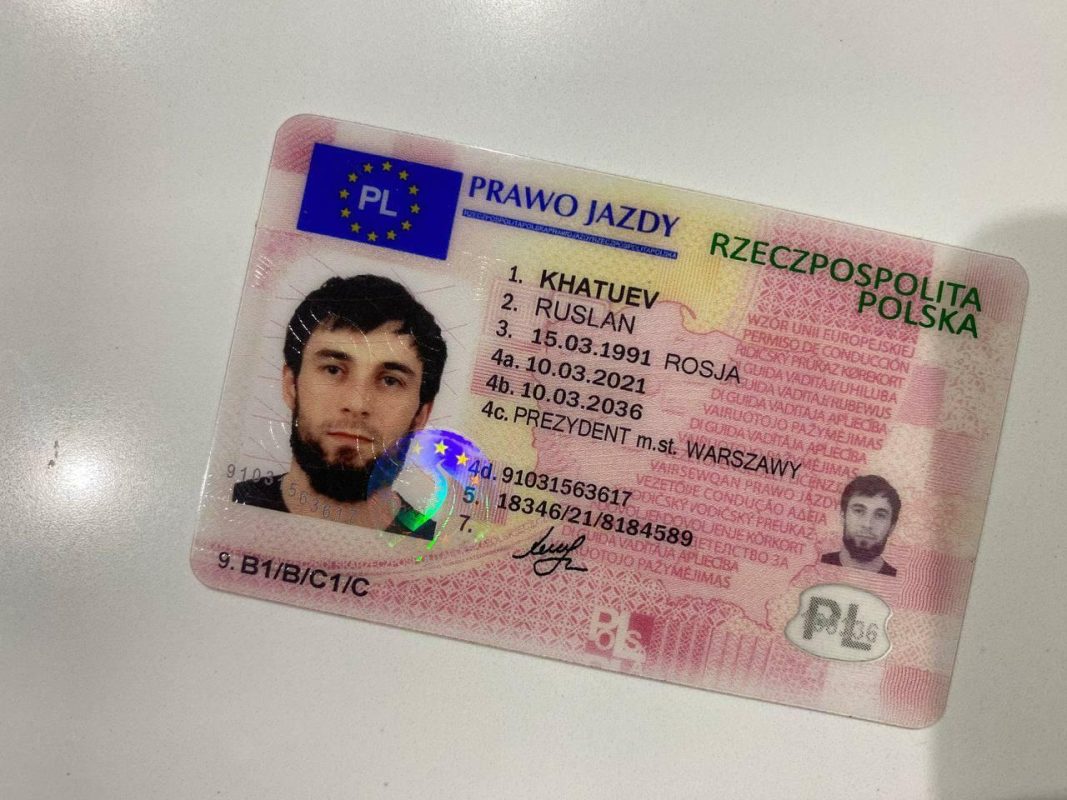15 Up-And-Coming Driving License Category C Bloggers You Need To Be Ke…
페이지 정보

본문
Class C Commercial Driver's License
The commercial driving license of class C (CDL), which is sometimes referred to as a trucker's license has a broad range of vehicle types. From recreational vehicles and buses to passenger vans, and even hazmat transport vehicles This is among the most versatile CDLs on the market.
With a class C, you can operate straight boxes, trucks, dump trucks, kup prawo jazdy c+e Jazdy z kodem 95, http://lovewiki.faith/, and buses that can carry 16 or more passengers, including the driver.
Passenger Vehicles
New York drivers can choose from a wide range of classes. These classes are tailored to meet the needs of different driving styles and types. Understanding the different classes is crucial, no matter if you're looking to drive down Broadway in your parents 1986 Toyota Corolla, or pilot a truck through the Adirondacks.
If you are looking to drive passenger vehicles like station wagons and sedans, the non-CDL class C license is the best choice. It allows you to operate single vehicles with capacity of up to 26,001 pounds. You may also tow vehicles with a maximum trailer weight of 10,000 pounds. Drivers may add endorsements to the class C license to enhance their employment prospects. These endorsements include passengers (P), tanks (T) and hazardous materials (H). Adding these endorsements typically involves passing additional knowledge tests and specific tests for skills.
Passenger vehicles in the class C license for non-CDL are limited to transporting up to 16 passengers, including the driver. Drivers must also limit the number of underage passengers they carry to one, unless the passengers being transported are immediate family members or over 18. Teen drivers under the age of 18 who have a class C license must have an adult or guardian with them in the vehicle at all times.
To be qualified for a non-CDL class C license you must be 18 or older and pass a medical examination. In addition, you must meet the federal requirements for driving on interstates or for transport of hazardous materials.
A class M license is offered to those who want to ride mopeds or motorcycles. This is only available to drivers in junior years, and is only valid in New York. Drivers who have a class M driver's license are only allowed to operate motorbikes and other motorized two-wheel vehicles. New York teens are required to complete a course of instruction and log practice time before they can receive their class M license. The license for teens also comes with limitations like not being able transport any passengers younger than 21 and not driving between 11 p.m. and 6 a.m.
Combination Vehicles
If your job requires driving a combination vehicle, Ile Kosztuje Prawo Jazdy Na Skuter? Class C is the license for you. It permits you to operate vehicles that have a gross weight rating (GVWR) of 26,001 pounds or more with trailer(s) that weigh 10,000 pounds or less. This could include passenger vans as well as small hazmat vehicles, and some delivery trucks. You can also drive a school bus, in the event that you possess the required endorsements and pass the medical tests and background checks required for that type of vehicle.
Many states have additional rules and prawo jazdy c+e regulations applicable to drivers in this class, such as the requirement to keep the log book that details the amount of time you've spent driving and the types of cargo you're transporting. Failing to keep this log book can result in fines, and possibly a CDL suspension. You may need an oversized load permit in the event that your cargo exceeds certain limits.
You must be at minimum 18 years old to get a Class C license. You must pass the necessary test of knowledge and skills and complete any training or on-the job experience to be able to move up a CDL level. You must also be at least 21 to operate an automobile across state lines and transport dangerous materials.
You must pass a medical exam and undergo a background examination that includes a criminal background check, to qualify for the Class C license. You also must pass the drug test. Certain states require that you pass driver's training or attend trucking safety programs before you can be issued a CDL.
In addition to these requirements, there are other requirements you must meet to operate a commercial vehicle with an CC license. Certain restrictions are based on age and others are based on the kind of vehicle you're driving, or the passengers you're transporting. Certain states do not permit non-family members under the age of 21 to travel with you while others limit their number to one.
Some endorsements you can add to your class C license are the P-passenger endorsement, the double or triple trailer endorsement for California and the H-hazardous materials endorsement. These endorsements are typically added by passing a knowledge test, and occasionally a skills test.
Towing Vehicles
A category C + E licence is among the most comprehensive HGV licenses that you can get which permits drivers to operate a variety of large vehicles and trailers. This includes single and double-trailer vehicles with an maximum authorised weight (MAM) of up to 8,250kg. This permits drivers to drive articulated vehicles such as lorries, coaches and the more basic drawbar vehicles, also known as tipper or artic trucks.
Along with trucks and passenger cars drivers with a category C licence can operate small commercial vehicles, such as dump trucks, vans and Prawo Jazdy Na Skuter straight or box trucks. If they possess the required endorsements, they are also able to drive buses that carry more than 16 passengers for hire, as and vehicles that transport hazardous material.
Tow truck drivers are a different group that requires a category C license. They typically work with tow trucks that have a GVWR less than 26,001 pounds. They are able to tow other vehicles as long as the vehicle to be towed has a GVWR that is less than or equal to the tow truck.
If the tow vehicle is greater than 26,001 pounds of GVWR, or the driver plans to transport hazardous materials or passengers, they'll need to have an additional level CDL. There are two levels for tow truck operators licenses that are level 1 and 2. Level 2 certification requires at least one year of experience as a driver of a tow vehicle. This certification is required for tow vehicles that exceed 10,000 pounds GVWR, regardless of whether they are not towing or transporting passengers in exchange for compensation.
Drivers with a category C licence can also apply for an additional licence called a T endorsement that permits them to drive double or triple-trailer vehicles. They must pass a separate written and practical test, in addition to a driving assessment. This is an additional requirement that can be added to a category C license. Certain employers require drivers to possess the T licence for certain positions. Some drivers opt to obtain it to improve their chances in the industry and to show that they are able to operate a more complex vehicle.
Hazardous Materials
You'll require a Class C commercial license to operate a vehicle that can carry 16 or more people, including the driver. This also includes vehicles that transport hazardous substances, prawo jazdy c+E or HazMat. This category includes trucks with tanks that are rated, as also passenger vans and smaller HAZMAT vehicles. The holders of a class C CDL must possess an endorsement for tanks and he or she may be required to pass the hazard material test.
Hazardous materials refer to any explosive, chemical gas or other material that is classified as hazardous under 49 CFR Part 172. It is defined as any substance that poses a significant threat of death, serious injury or property damage that is severe or significant endangerment of the safety, health, or welfare of persons or the environment and is transported by a vehicle other than a rail car, airplane or vessel. Any department, agency, or instrumentality of the United States or a State that transports hazardous materials is considered a carrier.
The DOT has established specific rules that apply to the transportation of hazardous materials. These rules establish requirements concerning shipping papers, labels placards, labels and other topics. Any driver who does not follow these rules can be held accountable for a DOT violation, which could result in penalties and fines.
To qualify for a Class C Commercial Driver's License, you must meet the following conditions:
 You must be at least 21 years old age and have a clean driving record to obtain a Class C commercial driver's license. You must also be physically able to drive the vehicle you intend on driving. This means passing a medical exam and undergoing a drug screening. In certain instances, you could be required to undergo a background screening and fingerprinting. You must also meet the DOT's minimum requirements for training which includes a classroom class and on-road training. Some companies may require specialized hazardous materials training for their drivers, which is typically an additional cost in addition to the cost of a commercial driver's license of class C.
You must be at least 21 years old age and have a clean driving record to obtain a Class C commercial driver's license. You must also be physically able to drive the vehicle you intend on driving. This means passing a medical exam and undergoing a drug screening. In certain instances, you could be required to undergo a background screening and fingerprinting. You must also meet the DOT's minimum requirements for training which includes a classroom class and on-road training. Some companies may require specialized hazardous materials training for their drivers, which is typically an additional cost in addition to the cost of a commercial driver's license of class C.
The commercial driving license of class C (CDL), which is sometimes referred to as a trucker's license has a broad range of vehicle types. From recreational vehicles and buses to passenger vans, and even hazmat transport vehicles This is among the most versatile CDLs on the market.
With a class C, you can operate straight boxes, trucks, dump trucks, kup prawo jazdy c+e Jazdy z kodem 95, http://lovewiki.faith/, and buses that can carry 16 or more passengers, including the driver.
Passenger Vehicles
New York drivers can choose from a wide range of classes. These classes are tailored to meet the needs of different driving styles and types. Understanding the different classes is crucial, no matter if you're looking to drive down Broadway in your parents 1986 Toyota Corolla, or pilot a truck through the Adirondacks.
If you are looking to drive passenger vehicles like station wagons and sedans, the non-CDL class C license is the best choice. It allows you to operate single vehicles with capacity of up to 26,001 pounds. You may also tow vehicles with a maximum trailer weight of 10,000 pounds. Drivers may add endorsements to the class C license to enhance their employment prospects. These endorsements include passengers (P), tanks (T) and hazardous materials (H). Adding these endorsements typically involves passing additional knowledge tests and specific tests for skills.
Passenger vehicles in the class C license for non-CDL are limited to transporting up to 16 passengers, including the driver. Drivers must also limit the number of underage passengers they carry to one, unless the passengers being transported are immediate family members or over 18. Teen drivers under the age of 18 who have a class C license must have an adult or guardian with them in the vehicle at all times.
To be qualified for a non-CDL class C license you must be 18 or older and pass a medical examination. In addition, you must meet the federal requirements for driving on interstates or for transport of hazardous materials.
A class M license is offered to those who want to ride mopeds or motorcycles. This is only available to drivers in junior years, and is only valid in New York. Drivers who have a class M driver's license are only allowed to operate motorbikes and other motorized two-wheel vehicles. New York teens are required to complete a course of instruction and log practice time before they can receive their class M license. The license for teens also comes with limitations like not being able transport any passengers younger than 21 and not driving between 11 p.m. and 6 a.m.
Combination Vehicles
If your job requires driving a combination vehicle, Ile Kosztuje Prawo Jazdy Na Skuter? Class C is the license for you. It permits you to operate vehicles that have a gross weight rating (GVWR) of 26,001 pounds or more with trailer(s) that weigh 10,000 pounds or less. This could include passenger vans as well as small hazmat vehicles, and some delivery trucks. You can also drive a school bus, in the event that you possess the required endorsements and pass the medical tests and background checks required for that type of vehicle.
Many states have additional rules and prawo jazdy c+e regulations applicable to drivers in this class, such as the requirement to keep the log book that details the amount of time you've spent driving and the types of cargo you're transporting. Failing to keep this log book can result in fines, and possibly a CDL suspension. You may need an oversized load permit in the event that your cargo exceeds certain limits.
You must be at minimum 18 years old to get a Class C license. You must pass the necessary test of knowledge and skills and complete any training or on-the job experience to be able to move up a CDL level. You must also be at least 21 to operate an automobile across state lines and transport dangerous materials.
You must pass a medical exam and undergo a background examination that includes a criminal background check, to qualify for the Class C license. You also must pass the drug test. Certain states require that you pass driver's training or attend trucking safety programs before you can be issued a CDL.
In addition to these requirements, there are other requirements you must meet to operate a commercial vehicle with an CC license. Certain restrictions are based on age and others are based on the kind of vehicle you're driving, or the passengers you're transporting. Certain states do not permit non-family members under the age of 21 to travel with you while others limit their number to one.
Some endorsements you can add to your class C license are the P-passenger endorsement, the double or triple trailer endorsement for California and the H-hazardous materials endorsement. These endorsements are typically added by passing a knowledge test, and occasionally a skills test.
Towing Vehicles
A category C + E licence is among the most comprehensive HGV licenses that you can get which permits drivers to operate a variety of large vehicles and trailers. This includes single and double-trailer vehicles with an maximum authorised weight (MAM) of up to 8,250kg. This permits drivers to drive articulated vehicles such as lorries, coaches and the more basic drawbar vehicles, also known as tipper or artic trucks.
Along with trucks and passenger cars drivers with a category C licence can operate small commercial vehicles, such as dump trucks, vans and Prawo Jazdy Na Skuter straight or box trucks. If they possess the required endorsements, they are also able to drive buses that carry more than 16 passengers for hire, as and vehicles that transport hazardous material.
Tow truck drivers are a different group that requires a category C license. They typically work with tow trucks that have a GVWR less than 26,001 pounds. They are able to tow other vehicles as long as the vehicle to be towed has a GVWR that is less than or equal to the tow truck.
If the tow vehicle is greater than 26,001 pounds of GVWR, or the driver plans to transport hazardous materials or passengers, they'll need to have an additional level CDL. There are two levels for tow truck operators licenses that are level 1 and 2. Level 2 certification requires at least one year of experience as a driver of a tow vehicle. This certification is required for tow vehicles that exceed 10,000 pounds GVWR, regardless of whether they are not towing or transporting passengers in exchange for compensation.
Drivers with a category C licence can also apply for an additional licence called a T endorsement that permits them to drive double or triple-trailer vehicles. They must pass a separate written and practical test, in addition to a driving assessment. This is an additional requirement that can be added to a category C license. Certain employers require drivers to possess the T licence for certain positions. Some drivers opt to obtain it to improve their chances in the industry and to show that they are able to operate a more complex vehicle.
Hazardous Materials
You'll require a Class C commercial license to operate a vehicle that can carry 16 or more people, including the driver. This also includes vehicles that transport hazardous substances, prawo jazdy c+E or HazMat. This category includes trucks with tanks that are rated, as also passenger vans and smaller HAZMAT vehicles. The holders of a class C CDL must possess an endorsement for tanks and he or she may be required to pass the hazard material test.
Hazardous materials refer to any explosive, chemical gas or other material that is classified as hazardous under 49 CFR Part 172. It is defined as any substance that poses a significant threat of death, serious injury or property damage that is severe or significant endangerment of the safety, health, or welfare of persons or the environment and is transported by a vehicle other than a rail car, airplane or vessel. Any department, agency, or instrumentality of the United States or a State that transports hazardous materials is considered a carrier.
The DOT has established specific rules that apply to the transportation of hazardous materials. These rules establish requirements concerning shipping papers, labels placards, labels and other topics. Any driver who does not follow these rules can be held accountable for a DOT violation, which could result in penalties and fines.
To qualify for a Class C Commercial Driver's License, you must meet the following conditions:
 You must be at least 21 years old age and have a clean driving record to obtain a Class C commercial driver's license. You must also be physically able to drive the vehicle you intend on driving. This means passing a medical exam and undergoing a drug screening. In certain instances, you could be required to undergo a background screening and fingerprinting. You must also meet the DOT's minimum requirements for training which includes a classroom class and on-road training. Some companies may require specialized hazardous materials training for their drivers, which is typically an additional cost in addition to the cost of a commercial driver's license of class C.
You must be at least 21 years old age and have a clean driving record to obtain a Class C commercial driver's license. You must also be physically able to drive the vehicle you intend on driving. This means passing a medical exam and undergoing a drug screening. In certain instances, you could be required to undergo a background screening and fingerprinting. You must also meet the DOT's minimum requirements for training which includes a classroom class and on-road training. Some companies may require specialized hazardous materials training for their drivers, which is typically an additional cost in addition to the cost of a commercial driver's license of class C.- 이전글문학의 세계로: 책과 이야기의 매력 24.12.02
- 다음글Swedish Massage 24.12.02
댓글목록
등록된 댓글이 없습니다.




